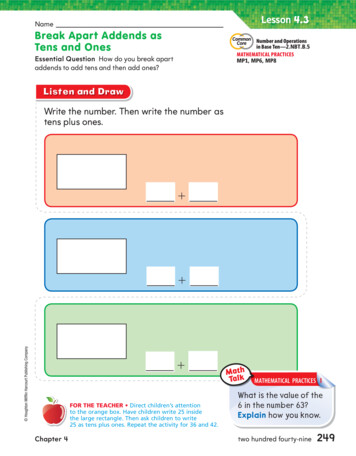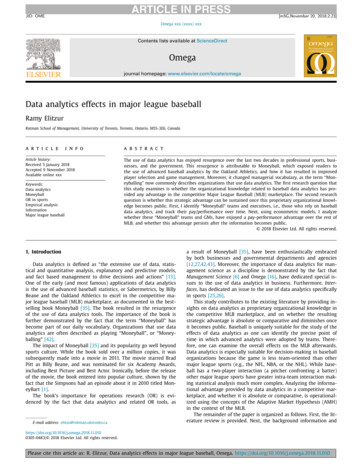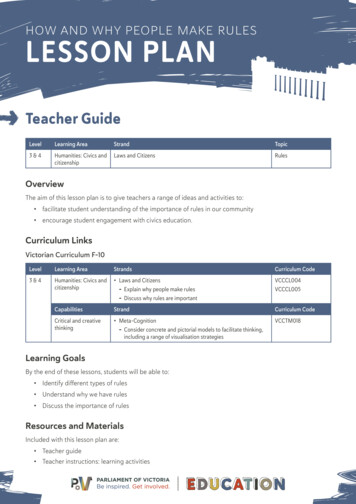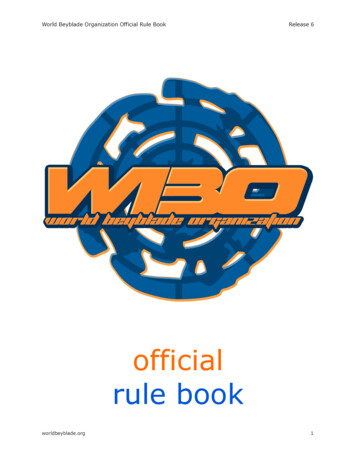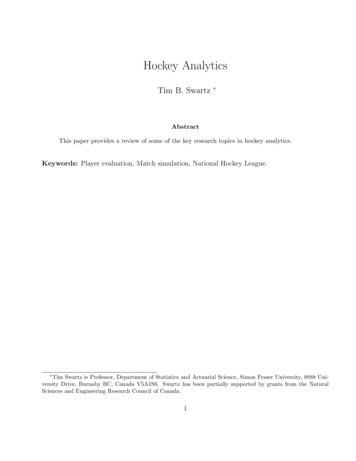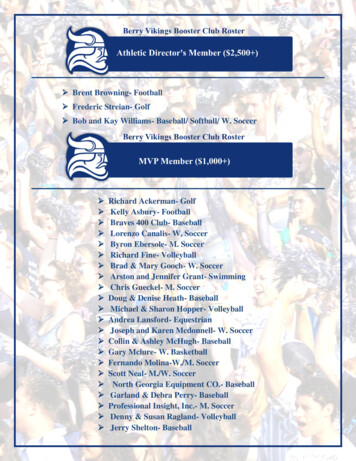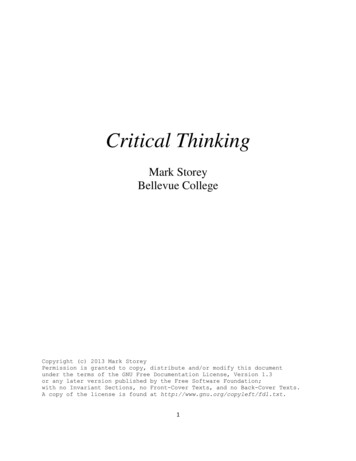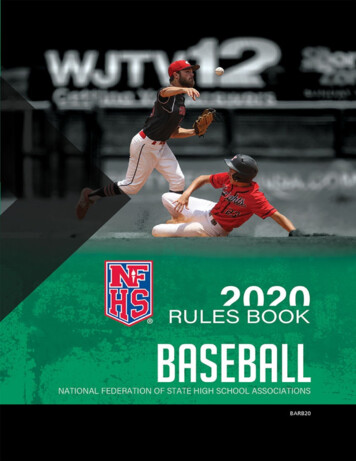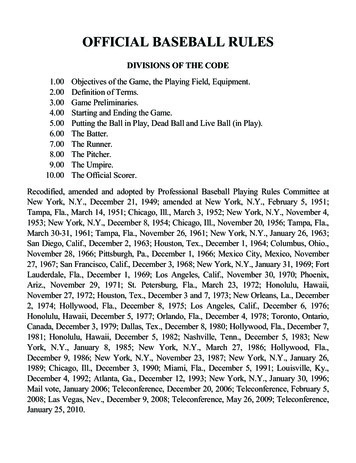
Transcription
OFFICIAL BASEBALL RULESDIVISIONS OF THE tives of the Game, the Playing Field, Equipment.Definition of Terms.Game Preliminaries.Starting and Ending the Game.Putting the Ball in Play, Dead Ball and Live Ball (in Play).The Batter.The Runner.The Pitcher.The Umpire.The Official Scorer.Recodified, amended and adopted by Professional Baseball Playing Rules Committee atNew York, N.Y., December 21, 1949; amended at New York, N.Y., February 5, 1951;Tampa, Fla., March 14, 1951; Chicago, Ill., March 3, 1952; New York, N.Y., November 4,1953; New York, N.Y., December 8, 1954; Chicago, Ill., November 20, 1956; Tampa, Fla.,March 30-31, 1961; Tampa, Fla., November 26, 1961; New York, N.Y., January 26, 1963;San Diego, Calif., December 2, 1963; Houston, Tex., December 1, 1964; Columbus, Ohio.,November 28, 1966; Pittsburgh, Pa., December 1, 1966; Mexico City, Mexico, November27, 1967; San Francisco, Calif., December 3, 1968; New York, N.Y., January 31, 1969; FortLauderdale, Fla., December 1, 1969; Los Angeles, Calif., November 30, 1970; Phoenix,Ariz., November 29, 1971; St. Petersburg, Fla., March 23, 1972; Honolulu, Hawaii,November 27, 1972; Houston, Tex., December 3 and 7, 1973; New Orleans, La., December2, 1974; Hollywood, Fla., December 8, 1975; Los Angeles, Calif., December 6, 1976;Honolulu, Hawaii, December 5, 1977; Orlando, Fla., December 4, 1978; Toronto, Ontario,Canada, December 3, 1979; Dallas, Tex., December 8, 1980; Hollywood, Fla., December 7,1981; Honolulu, Hawaii, December 5, 1982; Nashville, Tenn., December 5, 1983; NewYork, N.Y., January 8, 1985; New York, N.Y., March 27, 1986; Hollywood, Fla.,December 9, 1986; New York, N.Y., November 23, 1987; New York, N.Y., January 26,1989; Chicago, Ill., December 3, 1990; Miami, Fla., December 5, 1991; Louisville, Ky.,December 4, 1992; Atlanta, Ga., December 12, 1993; New York, N.Y., January 30, 1996;Mail vote, January 2006; Teleconference, December 20, 2006; Teleconference, February 5,2008; Las Vegas, Nev., December 9, 2008; Teleconference, May 26, 2009; Teleconference,January 25, 2010.
ForewordThis code of rules governs the playing of baseball games by professional teams of MajorLeague Baseball and the leagues that are members of the National Association ofProfessional Baseball Leagues.We recognize that many amateur and non-professional organizations play their games underprofessional rules and we are happy to make our rules available as widely as possible. It iswell to remember that specifications as to fields, equipment, etc., may be modified to meetthe needs of each group.Money fines, long-term suspensions and similar penalties imposed by this code are notpracticable for amateur groups, but officers and umpires of such organizations should insiston strict observance of all the rules governing the playing of the game.Baseball not only has maintained its position as the National Game of the United States, butalso has become an International Game being played in more than 100 countries. Thepopularity of the game will grow only so long as its players, managers, coaches, umpiresand administrative officers respect the discipline of its code of rules.PLAYING RULES COMMITTEESandy Alderson, ChairBob BebanRod CarewJohn McHale, Jr.Charlie RelifordTerry RyanJohn SchuerholzJimmie Lee SolomonBill StonemanAmateur baseball advisory member: Mike Gaski 2010 by the Commissioner of Baseball. All rights reserved.No part of the Official Baseball Rules may be reproduced or transmitted in any form or by any means, electronicor mechanical, including photocopy, recording or any information storage and retrieval system now known or tobe invented, without permission in writing from the Office of the Commissioner of Baseball.The Major League Baseball silhouetted batted logo is a registered trademark of Major League BaseballProperties, Inc.Cover photo by Jim McIsaac/Getty Images. 2009 by Getty Images.ii
IMPORTANT NOTEThe Playing Rules Committee, at its December 1977 meeting, voted to incorporate theNotes/Case Book/Comments section directly into the Official Baseball Rules at theappropriate places. Basically, the Case Book interprets or elaborates on the basic rules andin essence have the same effect as rules when applied to particular sections for which theyare intended.This arrangement is designed to give quicker access to any written language pertaining to anOfficial Rule and does not require a reader to refer to different sections of the OfficialBaseball Rules book in considering the application of a particular rule.Case Book material is printed in smaller type than the rule language and is labeled asComment.iii
Changes for the 2010 Major League SeasonThe Playing Rules Committee made the following changes that will be in effect for the2010 season: Revised rule on playing field layout to update practices on marking foul lines.(Rule 1.04) Revised rule on playing field layout to update base material. (Rule 1.06) Reduced maximum bat diameter to 2.61 inches. (Rule 1.10(a)) Revised rule on the use of helmets to require helmets while running the bases;update the requirement for Major League batters to use at least a single ear-flaphelmet; require base coaches to wear helmets while performing their duties; andrequire bat/ball boys and girls to wear double ear-flap helmets while performingtheir duties. (Rule 1.16) Added rules on substituted-for player who improperly remains in game. (Rule 3.03and 3.03 Comment) Revised rule on game preliminaries to provide that home team (rather than hometeam manager) determines whether a game shall not be started because of unsuitableweather conditions or the unfit condition of the playing field. (Rule 3.10(a)) Revised lineup-card rules to allow a manager’s designee to present lineup card andprovide that positions and substitutes should be listed as a courtesy. (Rule 4.01) Clarified that umpire interference may occur on a pick-off play or when a catcherreturns the ball to the pitcher. (Rules 2.00 (Interference) (c), 2.00 (Interference) (c)Comment, 5.09(b) and 5.09(b) Comment) Clarified language in rule on interference by a runner. (Rule 5.09(f))Revised diagram of field layout to provide that front and back lines of coach’sboxes may be a minimum of one foot in length and a maximum of 10 feet in length.(Diagram No. 1)Required cupped portion of bat, if any, to be free of right angles. (Rule 1.10(b))Added comment to address consequences of using bat with excessive pine tar.(Rule 1.10(c) Comment)Clarified rules on a ball that deflects to hit a batter or a bat while the batter is in alegal position in the batter’s box and has not intended to interfere with the course ofthe ball. (Rules 6.05(g) and 6.05(h))iv
Changes for the 2010 Major League Season Revised Designated Hitter Rule to provide for remedies when a team lists 10players on its lineup card but fails to indicate a Designated Hitter. (Rule 6.10(b)(1),6.10(b)(1) Comment and 6.10(b)(11)) Revised Designated Hitter Rule to provide that a team’s Designated Hitter roleterminates when a player on defense replaces the pitcher. (Rule 6.10(b)(14)) Revised Designated Hitter Rule to restrict appearance of Designated Hitter inbullpen. (Rule 6.10(b)(15)) Reorganized rule on runner advancing when a fielder deliberately touches a pitchedball with his cap, mask or any part of his uniform detached from its proper place onhis person. (Rule 7.04(e)) Revised language of rule on putting out forced runner. (Rule 7.08(e)) Revised rule on reversing a call after umpire crew consultation to empower umpiresexplicitly to take whatever steps they may deem necessary, in their discretion, toeliminate the results and consequences of an earlier call that they are reversing.(Rule 9.02(c) and 9.02(c) Comment) Made stylistic revisions in Rules 1.10(c), 2.00 (Interference) (a) Comment, 3.10(a),6.10(a), 6.10(b), 8.01(a)(1)Revised rule on pitchers to allow pitcher to touch his mouth or lips on mound, solong as he is not in contact with pitcher’s plate when doing so and so long as heclearly wipes the fingers of his pitching hand dry before touching the pitcher’s plate.(Rule 8.02(a)(1))The Playing Rules Committee made the following changes in 2009 that went into effectfor the 2009 season in National Association leagues: Revised suspended game rules to permit a National Association League to adoptany of Rules 4.12(a)(7), 4.12(a)(8) or 4.12(a)(9) for its post-season games. (Rule4.12(a)) Added a cross-reference in Rule 4.12(a)(8).Made stylistic revisions in Rules 4.12(a)(8) and 4.12(a)(9).In addition, the index has been revised.v
Rule 1.01 to 1.041.00—Objectives of the Game.1.01 Baseball is a game between two teams of nine players each, under direction of amanager, played on an enclosed field in accordance with these rules, under jurisdiction ofone or more umpires.1.02The objective of each team is to win by scoring more runs than the opponent.1.03 The winner of the game shall be that team which shall have scored, in accordancewith these rules, the greater number of runs at the conclusion of a regulation game.1.04 THE PLAYING FIELD. The field shall be laid out according to the instructionsbelow, supplemented by Diagrams No. 1, No. 2 and No. 3 on adjoining pages.The infield shall be a 90-foot square. The outfield shall be the area between twofoul lines formed by extending two sides of the square, as in Diagram 1. The distance fromhome base to the nearest fence, stand or other obstruction on fair territory shall be 250 feetor more. A distance of 320 feet or more along the foul lines, and 400 feet or more to centerfield is preferable. The infield shall be graded so that the base lines and home plate arelevel. The pitcher’s plate shall be 10 inches above the level of home plate. The degree ofslope from a point 6 inches in front of the pitcher’s plate to a point 6 feet toward home plateshall be 1 inch to 1 foot, and such degree of slope shall be uniform. The infield and outfield,including the boundary lines, are fair territory and all other area is foul territory.It is desirable that the line from home base through the pitchers plate to second baseshall run East-Northeast.It is recommended that the distance from home base to the backstop, and from thebase lines to the nearest fence, stand or other obstruction on foul territory shall be 60 feet ormore. See Diagram 1.When location of home base is determined, with a steel tape measure 127 feet, 3⅜inches in desired direction to establish second base. From home base, measure 90 feettoward first base; from second base, measure 90 feet toward first base; the intersection ofthese lines establishes first base. From home base, measure 90 feet toward third base; fromsecond base, measure 90 feet toward third base; the intersection of these lines establishesthird base. The distance between first base and third base is 127 feet, 3⅜ inches. Allmeasurements from home base shall be taken from the point where the first and third baselines intersect.1
Rule 1.04 to 1.06The catcher’s box, the batters’ boxes, the coaches’ boxes, the three-foot first baselines and the next batter’s boxes shall be laid out as shown in Diagrams 1 and 2.The foul lines and all other playing lines indicated in the diagrams by solid blacklines shall be marked with paint or non-toxic and non-burning chalk or other white material.The grass lines and dimensions shown on the diagrams are those used in manyfields, but they are not mandatory and each club shall determine the size and shape of thegrassed and bare areas of its playing field.NOTE:(a)Any Playing Field constructed by a professional club after June 1,1958, shall provide a minimum distance of 325 feet from home baseto the nearest fence, stand or other obstruction on the right and leftfield foul lines, and a minimum distance of 400 feet to the centerfield fence.(b) No existing playing field shall be remodeled after June 1, 1958, insuch manner as to reduce the distance from home base to the foulpoles and to the center field fence below the minimum specified inparagraph (a) above.1.05 Home base shall be marked by a five-sided slab of whitened rubber. It shall be a17-inch square with two of the corners removed so that one edge is 17 inches long, twoadjacent sides are 8½ inches and the remaining two sides are 12 inches and set at an angle tomake a point. It shall be set in the ground with the point at the intersection of the linesextending from home base to first base and to third base; with the 17-inch edge facing thepitcher’s plate, and the two 12-inch edges coinciding with the first and third base lines. Thetop edges of home base shall be beveled and the base shall be fixed in the ground level withthe ground surface. (See drawing D in Diagram 2.)1.06 First, second and third bases shall be marked by white canvas or rubber-coveredbags, securely attached to the ground as indicated in Diagram 2. The first and third basebags shall be entirely within the infield. The second base bag shall be centered on secondbase. The bags shall be 15 inches square, not less than three nor more than five inches thick,and filled with soft material.2
GRASE'0"13'95'RADIUSS LIN'0"LINUFOE3'9090NLIFOULLE127-3 3/8"127-3 3/8"13'18' CIRCLE20110 ' MI’M NAX15'13'6'COACH'SBOX3'60'6"3'45'-0"'45'-0"110 ' MI’M NAX6'OR37'STANAND5' CIRCLEGR5' CIRCLE60'RADHOM IUS FROEBASE MD37'BACKSTOPDIAGRAM NO. 1LEGENDBATTER'S BOX,CATCHER'S BOX, FOUL LINE,PITCHER'S PLATE, COACH'S BOXNEXT BATTER'S BOXBASE LINESGRASS LINES3ORNEXT BATTER'S BOXNEXT BATTER'S BOXFENC26' CIRCLEFO E 60'UFRLLIONMEBASECOACH'SBOX
"1515"A90LAYOUT ATSECOND BASELINEULFOFOUL9090NELIALAYOUT ATTHIRD BASEALAYOUT ATFIRST BASELAYOUT AT PITCHER'S PLATESEE DIAGRAM NO. 3E90BB3'0"D3'0"81 2 "81 2 "6" 17" 6"4'0"4'0"8'0"C43"LAYOUT AT HOME BASEDIAGRAM NO. 2LEGENDABCDE1st, 2nd, 3rd BASESBATTER'S BOXCATCHER'S BOXHOME BASEPITCHER'S PLATE4
Suggested Layout of Pitching MoundThis Diagram No. 3 supplements and, in cases of difference, supersedes Diagram No. 2.REAR SLOPEGRADUAL TO CIRCLE EDGELEVEL 0'1"6'DIAGRAM NO. 3Pitching Mound: An 18' diameter circle,center of which is 59' from back of home plate.Locate front edge of rubber 18" behindcenter of mound.Front edge of rubber to back pointof home plate, 60'6".The degree of slope from a startingpoint 6" in front of the pitcher's plate toa point 6' toward home plate shallbe 1" to 1', and such degree of slopeshall be uniform.Level area surrounding rubber should be 6"in front of rubber, 18" to each side and 22"to rear of rubber. Total level area 5' x 34".Slope starts 6" from front edge of rubber.5
Rule 1.07 to 1.101.07 The pitcher’s plate shall be a rectangular slab of whitened rubber, 24 inches by 6inches. It shall be set in the ground as shown in Diagrams 1 and 2, so that the distancebetween the pitcher’s plate and home base (the rear point of home plate) shall be 60 feet, 6inches.1.08 The home club shall furnish players’ benches, one each for the home and visitingteams. Such benches shall not be less than twenty-five feet from the base lines. They shallbe roofed and shall be enclosed at the back and ends.1.09 The ball shall be a sphere formed by yarn wound around a small core of cork, rubberor similar material, covered with two strips of white horsehide or cowhide, tightly stitchedtogether. It shall weigh not less than five nor more than 5¼ ounces avoirdupois and measurenot less than nine nor more than 9¼ inches in circumference.1.10(a)The bat shall be a smooth, round stick not more than 2.61 inches in diameter at thethickest part and not more than 42 inches in length. The bat shall be one piece ofsolid wood.NOTE: No laminated or experimental bats shall be used in a professional game(either championship season or exhibition games) until the manufacturer has securedapproval from the Rules Committee of his design and methods of manufacture.(b)Cupped Bats. An indentation in the end of the bat up to one inch in depth ispermitted and may be no wider than two inches and no less than one inch indiameter. The indentation must be free of right angles and may not contain anyforeign substance.(c)The bat handle, for not more than 18 inches from its end, may be covered or treatedwith any material or substance to improve the grip. Any such material or substancethat extends past the 18-inch limitation shall cause the bat to be removed from thegame.NOTE: If the umpire discovers that the bat does not conform to (c) above until atime during or after which the bat has been used in play, it shall not be grounds fordeclaring the batter out, or ejected from the game.6
Rule 1.10 to 1.11Rule 1.10(c) Comment: If pine tar extends past the 18-inch limitation, then the umpire, on hisown initiative or if alerted by the opposing team, shall order the batter to use a different bat. Thebatter may use the bat later in the game only if the excess substance is removed. If no objections areraised prior to a bat’s use, then a violation of Rule 1.10(c) on that play does not nullify any action orplay on the field and no protests of such play shall be allowed.(d)1.11(a)No colored bat may be used in a professional game unless approved by the RulesCommittee.(1) All players on a team shall wear uniforms identical in color, trim and style, andall players uniforms shall include minimal six-inch numbers on their backs.(2) Any part of an undershirt exposed to view shall be of a uniform solid color forall players on a team. Any player other than the pitcher may have numbers,letters, insignia attached to the sleeve of the undershirt.(3) No player whose uniform does not conform to that of his teammates shall bepermitted to participate in a game.(b)A league may provide that(1) each team shall wear a distinctive uniform at all times, or(2) that each team shall have two sets of uniforms, white for home games and adifferent color for road games.(c)(1) Sleeve lengths may vary for individual players, but the sleeves of eachindividual player shall be approximately the same length.(2) No player shall wear ragged, frayed or slit sleeves.(d)No player shall attach to his uniform tape or other material of a different color fromhis uniform.(e)No part of the uniform shall include a pattern that imitates or suggests the shape of abaseball.7
Rule 1.11 to 1.13(f)Glass buttons and polished metal shall not be used on a uniform.(g)No player shall attach anything to the heel or toe of his shoe other than the ordinaryshoe plate or toe plate. Shoes with pointed spikes similar to golf or track shoes shallnot be worn.(h)No part of the uniform shall include patches or designs relating to commercialadvertisements.(i)A league may provide that the uniforms of its member teams include the names ofits players on their backs. Any name other than the last name of the player must beapproved by the League President. If adopted, all uniforms for a team must have thenames of its players.1.12 The catcher may wear a leather mitt not more than thirty-eight inches incircumference, nor more than fifteen and one-half inches from top to bottom. Such limitsshall include all lacing and any leather band or facing attached to the outer edge of the mitt.The space between the thumb section and the finger section of the mitt shall not exceed sixinches at the top of the mitt and four inches at the base of the thumb crotch. The web shallmeasure not more than seven inches across the top or more than six inches from its top to thebase of the thumb crotch. The web may be either a lacing or lacing through leather tunnels,or a center piece of leather which may be an extension of the palm, connected to the mittwith lacing and constructed so that it will not exceed any of the above mentionedmeasurements.1.13 The first baseman may wear a leather glove or mitt not more than twelve incheslong from top to bottom and not more than eight inches wide across the palm, measuredfrom the base of the thumb crotch to the outer edge of the mitt. The space between thethumb section and the finger section of the mitt shall not exceed four inches at the top of themitt and three and one-half inches at the base of the thumb crotch. The mitt shall beconstructed so that this space is permanently fixed and cannot be enlarged, extended,widened, or deepened by the use of any materials or process whatever. The web of the mittshall measure not more than five inches from its top to the base of the thumb crotch. Theweb may be either a lacing, lacing through leather tunnels, or a center piece of leather whichmay be an extension of the palm connected to the mitt with lacing and constructed so that itwill not exceed the above mentioned measurements. The webbing shall not be constructed8
Rule 1.13 to 1.15of wound or wrapped lacing or deepened to make a net type of trap. The glove may be ofany weight.1.14 Each fielder, other than the first baseman or catcher, may use or wear a leatherglove. The measurements covering size of glove shall be made by measuring front side orball receiving side of glove. The tool or measuring tape shall be placed to contact thesurface or feature of item being measured and follow all contours in the process. The gloveshall not measure more than 12" from the tip of any one of the 4 fingers, through the ballpocket to the bottom edge or heel of glove. The glove shall not measure more than 7¾"wide, measured from the inside seam at base of first finger, along base of other fingers, tothe outside edge of little finger edge of glove. The space or area between the thumb and firstfinger, called crotch, may be filled with leather webbing or back stop. The webbing may beconstructed of two plies of standard leather to close the crotch area entirely, or it may beconstructed of a series of tunnels made of leather, or a series of panels of leather, or of lacingleather thongs. The webbing may not be constructed of wound or wrapped lacing to make anet type of trap. When webbing is made to cover entire crotch area, the webbing can beconstructed so as to be flexible. When constructed of a series of sections, they must bejoined together. These sections may not be so constructed to allow depression to bedeveloped by curvatures in the section sides. The webbing shall be made to control the sizeof the crotch opening. The crotch opening shall measure not more than 4½" at the top, notmore than 5¾" deep, and shall be 3½" wide at its bottom. The opening of crotch shall not bemore than 4½" at any point below its top. The webbing shall be secured at each side, and attop and bottom of crotch. The attachment is to be made with leather lacing, theseconnections to be secured. If they stretch or become loose, they shall be adjusted to theirproper condition. The glove can be of any weight. See Diagram No. 4.1.15(a)The pitcher’s glove may not, exclusive of piping, be white, gray, nor, in thejudgment of an umpire, distracting in any manner.(b)No pitcher shall attach to his glove any foreign material of a color different from theglove.(c)The umpire-in-chief shall cause a glove that violates Rules 1.15(a) or 1.15(b) to beremoved from the game, either on his own initiative, at the recommendation of9
HCHHFEHGADBHIJKLMDIAGRAM NO. 4(A) Palm width—7 /4"(B) Palm width—8"(C) Top opening of web—41/2"(webbing not to be widerthan 41/2" at any point)(D) Bottom opening of web—3 1/2"(E) Web top to bottom—5 3/4"(F) 1st finger crotch seam—51/2"(G) Thumb crotch seam—51/2"(H) Crotch seam—13 3/4"(I) Thumb top to bottom edge—7 3/4"(J) 1st finger top to bottom edge—12"(K) 2nd finger top to bottom edge—113/4"(L) 3rd finger top to bottom edge—10 3/4"(M) 4th finger to bottom edge—9"310
Rule 1.15 to 1.17another umpire or upon complaint of the opposing manager that the umpire-in-chiefagrees has merit.1.16 A Professional League shall adopt the following rule pertaining to the use ofhelmets:(a)All players shall use some type of protective helmet while at bat.(b)All players in National Association Leagues shall wear a double ear-flap helmetwhile at bat.(c)All Major League players must wear a single ear-flap helmet (or at the player’soption, a double ear-flap helmet).(d)All catchers shall wear a catcher’s protective helmet, while fielding their position.(e)All base coaches shall wear a protective helmet while performing their duties.(f)All bat/ball boys or girls shall wear a double ear-flap protective helmet whileperforming their duties.Rule 1.16 Comment: If the umpire observes any violation of these rules, he shall direct theviolation to be corrected. If the violation is not corrected within a reasonable time, in the umpire’sjudgment, the umpire shall eject the offender from the game, and disciplinary action, as appropriate, willbe recommended.1.17 Playing equipment including but not limited to the bases, pitcher’s plate, baseball,bats, uniforms, catcher’s mitts, first baseman’s gloves, infielders and outfielders gloves andprotective helmets, as detailed in the provisions of this rule, shall not contain any unduecommercialization of the product. Designations by the manufacturer on any such equipmentmust be in good taste as to the size and content of the manufacturer’s logo or the brand nameof the item. The provisions of this Section 1.17 shall apply to professional leagues only.NOTE: Manufacturers who plan innovative changes in baseball equipment forprofessional baseball leagues should submit same to the Official Playing RulesCommittee prior to production.11
Rule 2.002.00—Definitions of Terms.(All definitions in Rule 2.00 are listed alphabetically.)ADJUDGED is a judgment decision by the umpire.An APPEAL is the act of a fielder in claiming violation of the rules by the offensiveteam.A BALK is an illegal act by the pitcher with a runner or runners on base, entitlingall runners to advance one base.A BALL is a pitch which does not enter the strike zone in flight and is not struck atby the batter.Rule 2.00 (Ball) Comment: If the pitch touches the ground and bounces through the strike zone itis a “ball.” If such a pitch touches the batter, he shall be awarded first base. If the batter swings at such apitch after two strikes, the ball cannot be caught, for the purposes of Rule 6.05 (c) and 6.09 (b). If thebatter hits such a pitch, the ensuing action shall be the same as if he hit the ball in flight.A BASE is one of four points which must be touched by a runner in order to score arun; more usually applied to the canvas bags and the rubber plate which mark the basepoints.A BASE COACH is a team member in uniform who is stationed in the coach’s boxat first or third base to direct the batter and the runners.A BASE ON BALLS is an award of first base granted to a batter who, during histime at bat, receives four pitches outside the strike zone.A BATTER is an offensive player who takes his position in the batter’s box.BATTER-RUNNER is a term that identifies the offensive player who has justfinished his time at bat until he is put out or until the play on which he became a runnerends.12
Rule 2.00The BATTER’S BOX is the area within which the batter shall stand during his timeat bat.The BATTERY is the pitcher and catcher.BENCH OR DUGOUT is the seating facilities reserved for players, substitutes andother team members in uniform when they are not actively engaged on the playing field.A BUNT is a batted ball not swung at, but intentionally met with the bat and tappedslowly within the infield.A CALLED GAME is one in which, for any reason, the umpire-in-chief terminatesplay.A CATCH is the act of a fielder in getting secure possession in his hand or glove ofa ball in flight and firmly holding it; providing he does not use his cap, protector, pocket orany other part of his uniform in getting possession. It is not a catch, however, ifsimultaneously or immediately following his contact with the ball, he collides with a player,or with a wall, or if he falls down, and as a result of such collision or falling, drops the ball.It is not a catch if a fielder touches a fly ball which then hits a member of the offensive teamor an umpire and then is caught by another defensive player. If the fielder has made thecatch and drops the ball while in the act of making a throw following the catch, the ball shallbe adjudged to have been caught. In establishing the validity of the catch, the fielder shallhold the ball long enough to prove that he has complete control of the ball and that hisrelease of the ball is voluntary and intentional.Rule 2.00 (Catch) Comment: A catch is legal if the ball is finally held by any fielder, even thoughjuggled, or held by another fielder before it touches the ground. Runners may leave their bases the instantthe first fielder touches the ball. A fielder may reach over a fence, railing, rope or other line ofdemarcation to make a catch. He may jump on top of a railing, or canvas that may be in foul ground. Nointerference should be allowed when a fielder reaches over a fence, railing, rope or into a stand to catch aball. He does so at his own risk.If a fielder, attempting a catch at the edge of the dugout, is “held up” and kept from an apparent fallby a player or players of either team and the catch is made, it shall be allowed.The CATCHER is the fielder who takes his position back of the home base.13
Rule 2.00The CATCHER’S BOX is that area within which the catcher shall stand until thepitcher delivers the ball.THE CLUB is a person or group of persons responsible for assembling the teampersonnel, providing the playing field and required facilities, and representing the team inrelations with the league.A COACH is a team member in uniform appointed by the manager to perform suchduties as the manager may designate, such as but not limited to acting as base coach.A DEAD BALL is a ball out of play because of a legally created temporarysuspension of play.The DEFENSE (or DEFENSIVE) is the team, or any player of the team, in the field.A DOUBLE-HEADER is two regularly scheduled or resched
Baseball Rules book in considering the application of a particular rule. Case Book material is printed in smaller type than the rule language and is labeled as Comment. Changes for the 2010 Major League Seas

